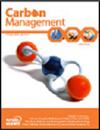畜牧业对减缓气候变化的贡献:来自低收入国家的视角
IF 3.2
4区 环境科学与生态学
Q3 ENVIRONMENTAL SCIENCES
引用次数: 0
摘要
本文章由计算机程序翻译,如有差异,请以英文原文为准。
The contribution of livestock to climate change mitigation: a perspective from a low-income country
Abstract The livestock sector in low- and middle-income countries could contribute significantly to reduce the rate of growth and/or the level of greenhouse gas (GHG) emissions required to achieve the 1.5 °C target of the Paris Agreement. Yet, the sector is also expected to contribute to food and income security in these countries. Using an extensive dataset on the Ethiopian livestock sector, we assessed the potential of selected interventions to increase supply of animal source protein (ASP) and reduce GHG emissions intensity or absolute emissions at national level. The business as usual (BAU) scenario was modelled by extrapolating the historical trends observed during the base years (i.e. 2010 – 2020) to the period between 2021 and 2030. Four scenarios were modelled including structural changes in cattle herd (S1) and chicken flock (S3) composition, increased milk yields of dairy cattle (S2), and a combination of all strategies (S4). We found that the total ASP produced and supplied per capita, as well as total GHG emissions increased between 2021 and 2030 across all scenarios while emission intensities per unit ASP produced decreased. However, by 2030, the total GHG emissions in S1 (i.e. 146.7 MtCO2e) were lower than in the BAU scenario (i.e. 149.0 MtCO2e) while the total ASP supplied per capita was higher in the former (i.e. 6.84 kg) than the latter (i.e. 6.24 kg). These findings suggest that structural changes at herd level could reduce total GHG emissions and concomitantly increase ASP supply. Therefore, structural transformation could be a highly relevant policy option for low- and middle- income countries, where the livestock sector must address multiple goals including food and income security, and global climate commitments.
求助全文
通过发布文献求助,成功后即可免费获取论文全文。
去求助
来源期刊

Carbon Management
ENVIRONMENTAL SCIENCES-
CiteScore
5.80
自引率
3.20%
发文量
35
期刊介绍:
Carbon Management is a scholarly peer-reviewed forum for insights from the diverse array of disciplines that enhance our understanding of carbon dioxide and other GHG interactions – from biology, ecology, chemistry and engineering to law, policy, economics and sociology.
The core aim of Carbon Management is it to examine the options and mechanisms for mitigating the causes and impacts of climate change, which includes mechanisms for reducing emissions and enhancing the removal of GHGs from the atmosphere, as well as metrics used to measure performance of options and mechanisms resulting from international treaties, domestic policies, local regulations, environmental markets, technologies, industrial efforts and consumer choices.
One key aim of the journal is to catalyse intellectual debate in an inclusive and scientific manner on the practical work of policy implementation related to the long-term effort of managing our global GHG emissions and impacts. Decisions made in the near future will have profound impacts on the global climate and biosphere. Carbon Management delivers research findings in an accessible format to inform decisions in the fields of research, education, management and environmental policy.
 求助内容:
求助内容: 应助结果提醒方式:
应助结果提醒方式:


